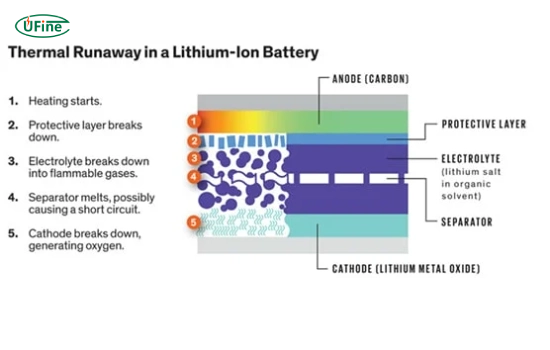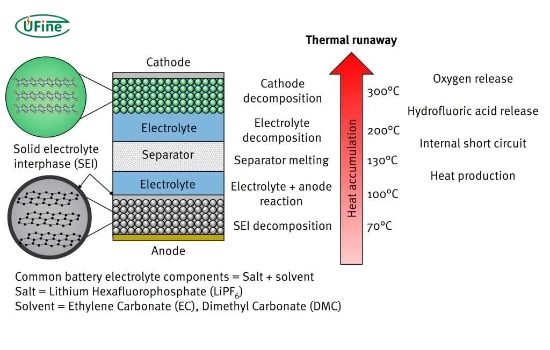Thermal runaway in lithium-ion batteries is a critical safety issue that has gained significant attention recently due to its potential to cause fires and explosions. Understanding this phenomenon is crucial for industries that rely on lithium-ion batteries, from electric vehicles to consumer electronics. This article will dive deep into the causes, effects, and prevention methods of thermal runaway in lithium-ion batteries, ensuring a comprehensive understanding of the topic.
Thermal runaway in a lithium‑ion battery is a self‑sustaining, rapid increase in temperature and pressure caused by exothermic reactions, which can lead to fire or explosion.
Part 1. What is thermal runaway in a lithium‑ion battery?
Thermal runaway is a chain reaction inside a lithium‑ion cell where heat generation from internal reactions exceeds dissipation, causing rapid temperature and pressure rise that may rupture the cell.
This phenomenon occurs when the battery’s internal temperature exceeds a critical threshold, causing self-sustaining exothermic reactions. These reactions produce more heat than the battery system can dissipate, creating a dangerous feedback loop.

Part 2. Why does thermal runaway occur?
Several factors, including overcharging, internal short circuits, mechanical damage, high operating temperatures, and manufacturing defects trigger thermal runaway in lithium‑ion batteries.
| Trigger | Mechanism | Prevention Tip |
|---|---|---|
| Overcharge | Excess voltage causes electrode decomposition and heat buildup | Use a BMS with overvoltage protection |
| Internal Short | Separator failure leads to direct contact between electrodes | Choose high‑quality separators and inspect cell integrity |
| Mechanical Abuse | Puncture or impact damages internal layers and creates hotspots | Implement shock‑absorbing enclosures |
| High Ambient Temperature | External heat destabilizes cell chemistry | Maintain proper cooling or ventilation |
| Manufacturing Defect | Contaminants or misalignment cause uneven heating | Source from reputable manufacturers |
For more details on cell‑level behavior, see our in‑depth guide to battery cell thermal runaway

- Overcharging: When a battery is charged beyond its recommended voltage, it can lead to excessive heat generation.
- Internal short circuits: Damage to the battery’s internal structure, such as separator failure, can cause short circuits, resulting in heat buildup.
- Mechanical damage: Physical impacts or punctures can damage the battery’s internal components, sparking thermal runaway.
- High operating temperatures: Exposing batteries to extreme heat can destabilize their chemical structure and trigger runaway reactions.
- Manufacturing defects: Poor-quality materials or assembly errors can create vulnerabilities in the battery, increasing the risk of thermal runaway.
Part 3. What happens during thermal runaway?
Thermal runaway progresses through heat generation, electrolyte decomposition, gas release, pressure buildup, and potentially fire or explosion.
When a lithium-ion battery experiences thermal runaway, the following stages typically occur:
- Heat generation: A triggering event, such as overcharging or a short circuit, raises the battery’s temperature.
- Gas release: The electrolyte decomposes, releasing flammable gases like oxygen and hydrogen.
- Pressure buildup: The accumulation of gases increases internal pressure, which can rupture the battery casing.
- Fire or explosion: If flammable gases ignite, a fire or explosion can result, often accompanied by toxic smoke.
Part 4. What are the risks of thermal runaway?
The risks associated with thermal runaway include:
- Fire hazards: Lithium-ion battery fires are challenging to extinguish and can spread quickly.
- Explosions: The rapid buildup of heat and pressure can lead to explosive ruptures.
- Toxic emissions: The breakdown of battery components during thermal runaway releases harmful gases, such as carbon monoxide and hydrofluoric acid.
- Property damage: Fires and explosions can cause significant damage to surrounding equipment and structures.
- Loss of life: In severe cases, thermal runaway incidents can result in injuries or fatalities.
Part 5. How can thermal runaway be prevented?
Preventing thermal runaway requires proper design, handling, and usage practices. Here are some effective prevention measures:
- Use of battery management systems (BMS): A BMS monitors and regulates a battery’s temperature, voltage, and current to prevent overcharging or overheating.
- Quality manufacturing: Choosing high-quality batteries from reputable manufacturers reduces the risk of defects that can cause thermal runaway.
- Temperature control: Avoid exposing batteries to extreme heat or cold, and ensure proper cooling mechanisms in applications like electric vehicles.
- Safe charging practices: Use chargers designed for the specific battery type and avoid overcharging or deep discharging.
- Regular inspections: Periodically check batteries for signs of damage or swelling.
Part 6. What industries are most affected by thermal runaway?
Thermal runaway is a significant concern in industries that rely heavily on lithium-ion batteries, such as:
- Electric vehicles (EVs): The high energy density of EV batteries makes them particularly susceptible to thermal runaway.
- Consumer electronics: Smartphones, laptops, and tablets can experience thermal runaway if mishandled or damaged.
- Energy storage systems: Due to their size and capacity, large-scale battery systems used in renewable energy storage pose unique risks.
- Aerospace and defense: Aircraft and military equipment batteries must meet stringent safety standards to prevent catastrophic failures.
Part 7. What advancements are being made to prevent thermal runaway?
Researchers and manufacturers are continually developing innovative solutions to mitigate thermal runaway risks. Some advancements include:
- Solid-state batteries: These batteries use solid electrolytes instead of liquid ones, reducing the risk of gas release and fires.
- Advanced thermal management systems: Improved cooling technologies help maintain safe operating temperatures.
- Non-flammable electrolytes: Research is underway to develop electrolytes that are less likely to ignite under high temperatures.
- Improved separators: High-quality, heat-resistant separators can prevent internal short circuits and thermal runaway.
- Early detection systems: Sensors that detect abnormal heat or gas buildup allow early intervention before thermal runaway occurs.
Part 8. How to handle a lithium-ion battery experiencing thermal runaway?
If a lithium-ion battery shows signs of thermal runaway, such as swelling, smoke, or excessive heat, follow these steps:
- Evacuate the area: Move people from the affected battery to minimize exposure to toxic fumes or potential explosions.
- Do not use water: Water can react with lithium, worsening the situation. Use a Class D fire extinguisher or sand to smother the flames.
- Ventilate the area: Open windows or use fans to disperse toxic gases.
- Contact emergency services: Call for professional assistance to deal with the situation safely.
- Proper disposal: Once the battery has cooled, take it to a certified recycling facility for safe disposal.
Part 9. What regulations govern lithium-ion battery safety?
Governments and regulatory bodies worldwide have implemented strict safety standards for lithium-ion batteries. Some key regulations include:
- UN 38.3: This standard outlines testing requirements for lithium-ion batteries during transportation.
- IEC 62133: A key standard for safely designing and testing lithium-ion batteries.
- UL 1642: This certification ensures the safety of lithium-ion cells used in consumer electronics.
- ISO 26262: Relevant for automotive applications, this standard focuses on functional safety for electric vehicles.
Part 10. FAQs about thermal runaway lithium ion battery
-
What are the early signs of thermal runaway?
Early signs include swelling, hissing sounds, excessive heat, and smoke from the battery. -
Can thermal runaway happen in all lithium-ion batteries?
Any lithium-ion battery is susceptible to thermal runaway if exposed to the right conditions, such as overcharging, damage, or overheating. -
Is there a way to stop thermal runaway once it starts?
Unfortunately, once thermal runaway begins, it is challenging to stop. Preventive measures are the best approach to avoiding it. -
Are lithium-ion batteries safe to use despite the risk of thermal runaway?
Yes, lithium-ion batteries are generally safe when used properly and with appropriate safety measures in place. -
How do I safely dispose of a damaged lithium-ion battery?
Please take damaged batteries to certified recycling centers. Do not throw them in regular trash, as they can pose fire and environmental hazards.
Related Tags:
More Articles

High‑Capacity 3S LiPo Batteries: 5000 mAh vs. 10000 mAh
Compare 3S LiPo 5000mAh vs 10000mAh batteries by weight, power, and use. Find the best fit for your drone, RC car, or boat setup.
Top 5 Applications for Small 3S LiPo Batteries
Small 3S LiPo batteries power drones, RC gear, wearables, and robotics with high energy and low weight. Making them ideal for compact electronics projects.
Building and Charging Your Own 3S LiPo Pack: A Step‑by‑Step Guide
Learn how to build, balance, and charge a 3S LiPo battery pack safely at home with this complete DIY guide for hobbyists and beginners.
How to Choose the Right LiPo Battery Plug Type?
Discover the best LiPo battery plug types, how to choose them, and expert tips for safe usage, soldering, and maintenance.
Choosing the Right Connector for Your 3S LiPo Battery
Choosing the right 3S LiPo connector depends on current, space, and use. Learn the pros and cons of XT60, JST, EC3, and more.



